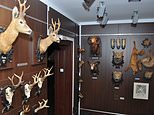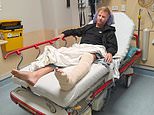
For thousands of years, humans had to hunt for food.
Then when they didn’t – they carried on hunting anyway, apparently for the thrill of it.
For those interested in delving further into the world of the hunter – and the hunted – there’s the unique and slightly macabre August von Spiess Museum of Hunting in Romania.
Some of the trophies on display at the unique and slightly macabre August von Spiess Museum of Hunting in Romania
The museum charts the history of hunting from the Stone Age to the 19th century, but with a specific focus on Colonel August von Spiess (1864-1953), the Keeper of the Royal Hunting under King Ferdinand I of Romania
In the second room of the museum, visitors can see hunting trophies that include a badger, left, and a wolf, right
It charts the history of hunting from the Stone Age to the 19th century, but with a specific focus on Colonel August von Spiess (1864-1953), the Keeper of the Royal Hunting under King Ferdinand I of Romania.
Not only is the museum, which opened in 1966, housed in his former residence in Sibiu in Transylvania, but much of the collection – comprising around 1,600 pieces – was donated by his daughters.
Von Spiess had a distinguished military career, retiring from the forces at the end of the First World War having risen, as his title intimates, to the rank of colonel. He was appointed the Keeper of Royal Hunting in 1921 – a position he held until 1939.
Von Spiess had a distinguished military career, retiring from the forces at the end of the First World War having risen, as his title intimates, to the rank of colonel. He is pictured second right in this 1887 snap
Von Spiess with his daughter Silvia on the Danube Delta, where he hunted pelicans during his research, which he donated to the Natural History Museum in Sibiu. In 1931, he helped to set up the Romanian Ornithological Observatory
Von Spiess had four daughters – Silvia, Trude, Ilse and Jutta. They were responsible for donating their father’s hunting collection and memorabilia to the museum after he died
In the 1930s, von Spiess went on two expeditions to Africa, where he completed his trophy collection with exotic species. This image was taken on one of those trips
Ana-Maria Papureanu, museum curator, said that von Spiess tried to teach his fellow hunters to respect and love nature, not only exploit it
In the late 1930s, he embarked on two expeditions to Africa to participate in safaris and to complete his trophy collection with exotic species. He had a collection of over 1,000 hunting trophies.
Von Spiess had a particular interest in birds of prey. He built three large and one small aviary in his garden and bred up to 15 eagles.
He also wrote several books on hunting and wildlife.
Inside the museum named in his honour, there are several rooms. In the first, visitors learn about the history of hunting with tools including lances, spears and crossbows on display.
The second room houses hunting trophies that include birds and some common small and medium-size fur animals.
The third room is dedicated to von Spiess himself with items on display including his favourite hunting gun, books, articles published in journals, personal items and photographs.
And the fourth room is filled with large hunting trophies from the Carpathian mountains, including deer, bears and a large boar.
The exhibition ends in the ‘African trophies room’, home to stuffed impalas, rhinos, zebras and oryx.
But even though the museum is filled with dead animals, its curator Ana-Maria Papureanu says von Spiess had a healthy respect for wildlife.
She told MailOnline Travel: ‘If I have to sum up our museum message and purpose, it’s that the natural riches of Romania’s fauna must be protected, and hunters are obligated to contribute to this purpose.
Inside the fourth room of the museum, which is filled with large hunting trophies from the Carpathian mountains, including deer, bears and a large boar
A grouse type bird on display in the museum’s second room. Curator Ana-Maria Papureanu said: ‘If I have to sum up our museum message and purpose, it’s that the natural riches of Romania’s fauna must be protected, and hunters are obligated to contribute to this purpose’
Some of the hunting tools and weapons displayed in the first room of the museum, which date back to the Stone Age
‘If habitats are protected then the wildlife is also. As a hunter you have to know your prey, learn its biology, behaviour and how it impacts the local ecosystem if you remove it.
‘We do not live anymore in a time when hunting is a means for survival. Today, hunting is called a sport but the ecosystem, the hunter’s sports field, might not recover from over-exploitation. If hunting is a sport then it has to be fair play.
‘This is what August von Spiess tried to teach his fellow hunters – to respect and love nature, not only exploit it.’
Source link
CHECK OUT: Top Travel Destinations
READ MORE: Travel News



